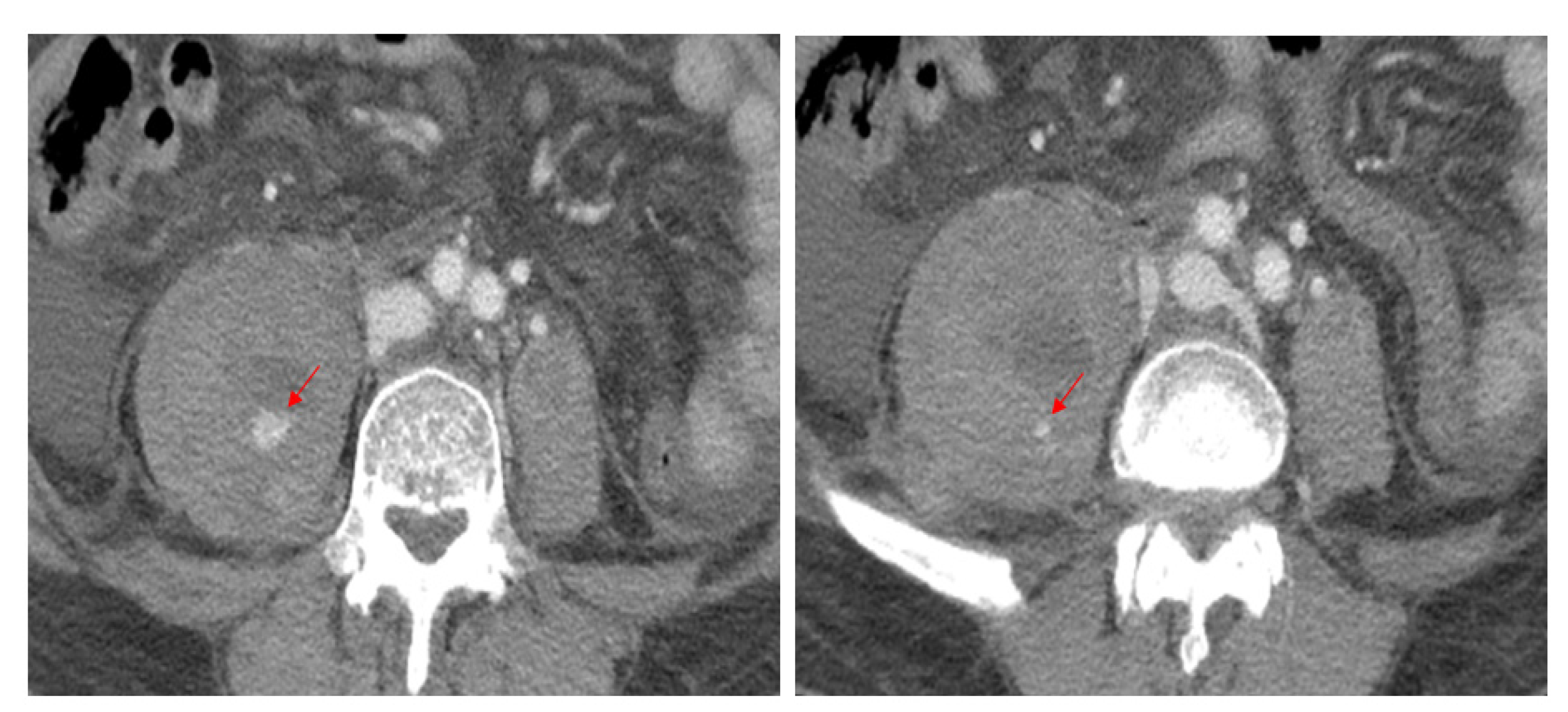Lumbar Plexus Palsy Caused by Massive Psoas Hematoma Related to Vertebral Compression Fracture in a Patient with Liver Cirrhosis
Abstract
:Author Contributions
Funding
Institutional Review Board Statement
Informed Consent Statement
Data Availability Statement
Conflicts of Interest
References
- Longo, U.G.; Loppini, M.; Denaro, L.; Maffulli, N.; Denaro, V. Conservative management of patients with an osteoporotic vertebral fracture: A review of the literature. J. Bone Jt. Surg. Br. 2012, 94, 152–157. [Google Scholar] [CrossRef] [PubMed]
- Shin, H.J.; Ha, S.W.; Kim, S.W. Delayed Onset Acute Subdural Hematoma after Burr Hole Drainage in a Patient with Chronic Subdural Hematoma and Liver Cirrhosis. Korean J. Neurotrauma 2021, 17, 156–161. [Google Scholar] [CrossRef] [PubMed]
- Di Bisceglie, A.M.; Richart, J.M. Spontaneous retroperitoneal and rectus muscle hemorrhage as a potentially lethal complication of cirrhosis. Liver Int. 2006, 26, 1291–1293. [Google Scholar] [CrossRef] [PubMed]
- Craxì, A.; Cammà, C.; Giunta, M. Clinical aspects of bleeding complications in cirrhotic patients. Blood Coagul. Fibrinolysis 2000, 11, S75–S79. [Google Scholar] [CrossRef] [PubMed]
- Grønbæk, H.; Johnsen, S.P.; Jepsen, P.; Gislum, M.; Vilstrup, H.; Tage-Jensen, U.; Sørensen, H.T. Liver cirrhosis, other liver diseases, and risk of hospitalisation for intracerebral haemorrhage: A Danish population-based case-control study. BMC Gastroenterol. 2008, 8, 16. [Google Scholar] [CrossRef] [PubMed] [Green Version]
- Goodfellow, J.; Fearn, C.B.; Matthews, J.M. Iliacus haematoma. A common complication of haemophilia. J. Bone Jt. Surg. Br. 1967, 49, 748–756. [Google Scholar] [CrossRef] [Green Version]
- Lee, S.Y.; Seok, H.; Kim, H.J.; Ahn, J.Y.; Kim, S.H. Psoas Hematoma with a Large Pseudoaneurysm Causing Lumbar Plexopathy after Endoscopic Lumbar Decompression: A Case Report. J. Electrodiagn. Neuromuscul. Dis. 2020, 22, 100–103. [Google Scholar] [CrossRef]
- Conesa, X.; Ares, O.; Seijas, R. Massive psoas haematoma causing lumbar plexus palsy: A case report. J. Orthop. Surg. 2012, 20, 94–97. [Google Scholar] [CrossRef] [PubMed]
- Klein, S.M.; D’Ercole, F.; Greengrass, R.A.; Warner, D.S. Enoxaparin associated with psoas hematoma and lumbar plexopathy after lumbar plexus block. Anesthesiology 1997, 87, 1576–1579. [Google Scholar] [CrossRef] [PubMed]
- Yamashita, S.; Tanaka, N.; Nomura, Y. Iliopsoas muscle hematoma secondary to alcoholic liver cirrhosis. Case Rep. Gastroenterol. 2012, 6, 704–711. [Google Scholar] [CrossRef] [PubMed]



Disclaimer/Publisher’s Note: The statements, opinions and data contained in all publications are solely those of the individual author(s) and contributor(s) and not of MDPI and/or the editor(s). MDPI and/or the editor(s) disclaim responsibility for any injury to people or property resulting from any ideas, methods, instructions or products referred to in the content. |
© 2022 by the authors. Licensee MDPI, Basel, Switzerland. This article is an open access article distributed under the terms and conditions of the Creative Commons Attribution (CC BY) license (https://creativecommons.org/licenses/by/4.0/).
Share and Cite
Ahn, S.H.; Kim, D.K.; Kim, S.W. Lumbar Plexus Palsy Caused by Massive Psoas Hematoma Related to Vertebral Compression Fracture in a Patient with Liver Cirrhosis. Diagnostics 2023, 13, 115. https://doi.org/10.3390/diagnostics13010115
Ahn SH, Kim DK, Kim SW. Lumbar Plexus Palsy Caused by Massive Psoas Hematoma Related to Vertebral Compression Fracture in a Patient with Liver Cirrhosis. Diagnostics. 2023; 13(1):115. https://doi.org/10.3390/diagnostics13010115
Chicago/Turabian StyleAhn, Seong Hwan, Dae Kyun Kim, and Seok Won Kim. 2023. "Lumbar Plexus Palsy Caused by Massive Psoas Hematoma Related to Vertebral Compression Fracture in a Patient with Liver Cirrhosis" Diagnostics 13, no. 1: 115. https://doi.org/10.3390/diagnostics13010115




